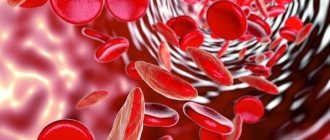Cardiovascular disease and anemia
The number of deaths from cardiovascular diseases (CVD) continues to rise worldwide. The conclusion that coronary heart disease (CHD) “... is the leading cause of death worldwide, its level is constantly growing and has now reached the proportions of a pandemic that knows no borders,” appeared on the website of the World Health Organization (WHO) in 2009 ., is perceived as increasingly relevant. In 2011, IHD caused the death of 7.3 million people [1, 2].
According to WHO estimates, 1.62 billion people suffer from anemia in the world [3]. The incidence of anemia, as well as coronary artery disease, increases significantly with age. More than 10% of people over 65 years of age and up to 50% of elderly patients with chronic diseases living in nursing homes have signs of anemia [4].
In the practice of general practitioners and cardiologists, a combination of cardiovascular pathology and anemia is often encountered. Anemia is detected in 25–40% of patients with chronic heart failure (CHF) and 10–20% of patients with coronary artery disease [5–7].
European and American recommendations for the management of patients with stable angina, issued in the last two years, require mandatory determination of hemoglobin levels in all patients and consider anemia as a factor provoking coronary insufficiency [8, 9]. In the latest recommendations for the diagnosis and treatment of patients with CHF, American and European experts note that anemia not only increases the symptoms of CHF, worsens the quality of life of patients, reduces exercise tolerance, and can cause the development of acute decompensation of CHF and an increase in the frequency of hospitalizations, but also an independent negative predictor of prognosis [10, 11]. The risk of death in CHF in patients with anemia is twice as high as without it, even when taking into account additional variables (renal dysfunction, severity of CHF, and others) [13]. Already latent iron deficiency can have a negative impact on the prognosis of CHF [14], which makes it advisable to determine its markers in all patients with CHF.
In acute coronary syndrome, the presence of anemia can quadruple the likelihood of death in patients and is considered an independent predictor of the risk of adverse clinical outcomes [15, 16]. Even chest pain syndrome in women, when combined with anemia, turns out to have a more unfavorable prognosis (the risk of death doubles) [17].
Preoperative anemia during cardiac surgery determines a high risk of subsequent blood transfusion and worse treatment results, which makes the task of early detection of anemia and high-quality, timely treatment urgent [18].
The role of anemia as an independent risk factor for poor prognosis in atrial fibrillation in elderly and senile people has been proven [19].
As shown by the analysis of the effect of the combination of anemia and impaired renal function on coronary artery disease in the population-based ARIC study (The Atherosclerosis Risk in Communities Study), anemia occurs in individuals with a slight and moderate decrease in renal function much more often than expected. And the combination of anemia and renal dysfunction significantly increases the risk of developing coronary artery disease, even after taking into account known risk factors such as diabetes mellitus, blood lipid levels, blood pressure and the use of antihypertensive therapy. The findings highlight the need for timely identification and treatment of anemia to improve patient prognosis [20].
The unfavorable mutual influence of CHF, anemia and renal dysfunction gave rise to the identification of new syndromes: “cardiorenal anemia syndrome”, “cardiorenal iron deficiency syndrome” and even “cardiorenal anemia and iron deficiency syndrome”. The latter terms emphasize the importance of iron deficiency as an independent risk factor for poor prognosis in CHF. The possibility of a direct effect of iron deficiency on diastolic function, hypertrophy, fibrosis and dilatation of the myocardium, the level of circulating erythropoietin, molecular signaling pathways and activation of inflammation has been proven in animal experiments [21]. This wide range of negative effects of iron deficiency is likely related to the role of iron in the body. It is not only part of hemoglobin and myoglobin, but is also found in enzymes involved in the conversion of adenosine triphosphate into adenosine diphosphate, promotes electron transport in mitochondrial chains, determines tissue metabolism and the absorption of free radicals [19]. Iron is involved in immune reactions and is necessary for the myelination of nerve fibers and DNA synthesis [22, 23].
Anemia in people with cardiovascular disease may have the same etiological factors as in the general population. An additional role in the development of anemia in cardiovascular pathology may be played by the older age of patients, which is itself associated with a lower hemoglobin value, the increasing incidence of chronic kidney disease, and the high prevalence of diabetes mellitus. It is assumed that the development of anemia in pathology of the cardiovascular system is contributed by: a chronic inflammatory process (increased synthesis of pro-inflammatory cytokines - tumor necrosis factor alpha, interleukin-6), ischemic depression of bone marrow hematopoiesis, decreased synthesis of endogenous erythropoietin due to renal dysfunction. In CHF, hemodilution with sodium and water retention and impaired absorption of iron and vitamins in the intestine may play a role in the formation of anemia. An additional factor for the development of anemia may be ongoing drug therapy that causes blood loss (when taking Aspirin, anticoagulants), a decrease in the production of erythropoietin and the sensitivity of the bone marrow to it (when using blockers of the renin-angiotensin-aldosterone system), etc.
The relevance of the issue of early diagnosis of anemia in patients with cardiovascular pathology is determined by the fact that its late detection leads to a delay or absence of the necessary intervention in relation to a potentially correctable condition.
A significant proportion of patients with cardiovascular pathology have latent iron deficiency, or iron deficiency anemia (IDA) or a combination of these conditions with other types of anemia.
Clinical signs of IDA consist of anemic and sideropenic syndromes, the latter is also determined by iron deficiency. Anemic syndrome may include the following manifestations: weakness, dizziness, syncope and orthostatic conditions, memory loss, epileptic seizures, symptoms of coronary insufficiency (anginal pain, repolarization disturbances on the ECG, arrhythmias), symptoms of myocardial insufficiency, systolic murmur on auscultation of the heart. Sideropenic syndrome leads to multiple disorders of various organs and systems. Lesions due to iron deficiency in the skin, skin appendages and mucous membranes (dryness, damage to hair and nails, etc.) are well known. No less common manifestations are symptoms from the gastrointestinal tract (decreased and perverted appetite, dysphagia, constipation or diarrhea, glossitis, burning tongue, esophagitis, dystrophic changes in the cells of the gastric mucosa); nervous system (increased fatigue, tinnitus, dizziness, headaches, decreased intellectual capabilities); cardiovascular system (tachycardia, diastolic dysfunction); urinary system (dysuria and urinary incontinence when coughing, laughing, nocturnal enuresis).
In the laboratory diagnosis of chronic IDA, microscopy of a peripheral blood smear reveals microcytic hypochromic anemia with hypoproliferation of reticulocytes. To confirm iron deficiency, reduced serum iron and ferritin levels are required.
Treatment of IDA is aimed at treating the disease underlying iron deficiency and actually compensating for iron deficiency.
Although patients with IDA need dietary advice, it is important to clearly explain that diet is not the basis of therapy. The largest amount of iron is found in meat (heme iron). All other foods contain less iron, and, most importantly, much less of them is absorbed (1–5% from apples, 10–15% from eggs and fish, and 25–30% from meat).
In drug therapy for IDA, the main focus has been and remains the use of iron supplements. The choice of iron drug is determined by its effectiveness (the amount and bioavailability of the iron it contains) and tolerability. An intake of 100 to 300 mg of elemental iron per day is required. The use of higher doses does not make sense, since iron absorption does not increase. Iron preparations on the domestic market are represented by hydroxypolymaltose complex, iron sorbitol complex, protein iron succinylate, iron sucrose complex. For patients with cardiac pathology, it is extremely important when carrying out additional drug therapy for IDA, in addition to high efficiency, the absence of negative drug interactions and good tolerability of the drug. The drug Maltofer, a polymaltose complex of iron sulfate (III), meets these requirements. Maltofer is a non-ionic iron preparation. Its absorption is ensured by active transport, without preliminary dissociation in the intestine, which eliminates the irritating effect on the mucous membrane and avoids most of the undesirable reactions from the gastrointestinal tract typical of ionized iron preparations [25, 26]. Maltofer does not interact with food or other medications, and the release form in the form of chewable tablets allows it to be used at any time and in any setting [27–30]. At the same time, the absorption of iron from other iron supplements may be reduced under the influence of substances contained in some foods - phytins (rice, soy), phosphates (fish, seafood), tannin (tea, coffee), while taking a number of medications (tetracyclines, antacids, calcium and magnesium salts), which requires taking these medications taking into account the time of consumption of food and these medications. Iron salt preparations contain divalent iron, which, after entering the blood, is converted into trivalent iron for its subsequent inclusion in the hemoglobin molecule, which can be accompanied by the formation of free radicals and have a negative effect on physiological processes in various organs and tissues [31]. Maltofer contains ferric iron, which is directly used to build the hemoglobin molecule, and therefore does not have a pro-oxidant effect [32]. When using iron supplements in adequate doses, a subjective improvement in well-being may be noted within a few days. The first objective criterion - reticulocyte crisis (an increase in the number of reticulocytes by 2-10 times compared to the initial one) is observed by the end of the first week of therapy. The absence of reticulocyte crisis indicates either an inadequate dose of the drug or an erroneous prescription of the drug. An increase in hemoglobin levels and the number of red blood cells is observed in the third week of therapy. After normalization of hemoglobin levels, a half dose of iron supplement is recommended for another 4–8 weeks to saturate the iron depot.
In 2013, the first recommendations for the treatment of anemia in patients with cardiovascular pathology were issued by the American College of Physicians [20]. They generally determine the tactics of managing a patient with cardiac pathology and anemia, regardless of its etiology. Three treatment strategies are considered: the use of erythropoietin-stimulating agents, red blood cell transfusion, and replenishment of iron deficiency. It is emphasized that red blood cell transfusion does not provide benefit and can cause harm to patients, so it is only possible in hospitalized severe patients with coronary artery disease with severe anemia. The use of erythropoietin-stimulating drugs for mild and moderate anemia in patients with CHF and coronary artery disease is not recommended due to the potential risk of thromboembolic complications and the lack of effect of therapy on the prognosis and frequency of hospitalizations. Positive data are currently available for the strategy of replenishing iron deficiency with intravenous administration of iron carboxymaltose; this tactic improves exercise tolerance, quality of life, reduces mortality and the frequency of hospitalizations [33].
Thus, anemia is a common comorbidity in cardiovascular diseases. Today in cardiology it is assessed as an independent predictor of the risk of adverse clinical outcomes, therefore patients with cardiovascular pathology need timely diagnosis of anemia in order to carry out adequate therapy.
Literature
- World Health Organization Cardiovascular diseases // Information bulletin No. 317. March 2013 [Electronic resource] - Access mode: https://www.who.int/mediacentre/factsheets/fs317/ru/ [Date of access: 10.04. 2014].
- World Health Organization 10 leading causes of death in the world // Information bulletin No. 310. July 2013 [Electronic resource] - Access mode: https://www.who.int/mediacentre/factsheets/fs310/ru/ [Access date: 04/10/2014].
- Worldwide prevalence of anemia 1993–2005. WHO Global Database on Anaemia. [Electronic resource] - Access mode: https://whqlibdoc.who.int/publications/2008/9789241596657_eng.pdf [Access date: 04/10/2014].
- Bross M.H., Soch K., Smith-Knuppel T. Anemia in older persons // Am Fam Physician. 2010. Sep 1; 82(5). P. 480–487.
- Boyd CM, Leff B, Wolff JL et al. Informing clinical practice guideline development and implementation: prevalence of coexisting conditions among adults with coronary heart disease // J Am Geriatr Soc. 2011. 59. P. 797–805.
- Felker GM, Adams KF Jr., Gattis WA et al. Anemia as a risk factor and therapeutic target in heart failure // J Am Coll Cardiol. 2004. 44. P. 959–966.
- Malyszko J., Bachorzewska-Gajewska H., Malyszko J. et al. Prevalence of chronic kidney disease and anemia in patients with coronary artery disease with normal serum creatinine undergoing percutaneous coronary interventions: relation to New York Heart Association class // Isr Med Assoc J. 2010. 12. P. 489–493.
- Stable Coronary Artery Disease (Management of). ESC Clinical Practice Guidelines. [Electronic resource] - Access mode: https://www.escardio.org/GUIDELINES-SURVEYS/ESC-GUIDELINES/Pages/GuidelinesList.aspx [Access date: 04/10/2014].
- Fihn SD, Cardin JM, Abrams J. et al. 2012 ACCF/AHA/ACP/FCP/AATS/PCNA/SCAI/ SNS Guideline for the Diagnosis and Management of Patients With Stable Ischemic Heart Disease // J. Am. Coll. Cardiol. 2012. Vol. 60. No. 24. P. e44-e164.
- 2013 ACCF/AHA Guideline for the Management of Heart Failure: A Report of the American College of Cardiology Foundation/American Heart Association Task Force on Practice Guidelines. [Electronic resource] - Access mode: https://circ.ahajournals.org/content/128/16/e240.extract [Access date: 04/10/2014].
- Acute and Chronic Heart Failure. ESC Clinical Practice Guidelines. [Electronic resource] - Access mode: https://www.escardio.org/GUIDELINES-SURVEYS/ESC-GUIDELINES/Pages/GuidelinesList.aspx [Access date: 04/10/2014].
- Groenveld HF, Januzzi JL, Damman K. et al. Anemia and mortality in heartfailure patients a systematic review and metaanalysis // J Am Coll Cardiol. 2008. 52 (10). P. 818–827.
- Jankowska E.A., Rozentryt P., Witkowska A. et al. Iron deficiency: an ominous sign in patients with systolic chronic heart failure // Eur Heart J. 2010. 31 (15). P. 1872–1880.
- Meneveau N., Schiele F., Seronde MF et al. Anemia for Risk Assessment of Patients With Acute Coronary Syndromes // Am J Cardiol. 2009. Feb 15; 103(4). P. 442–447.
- Hasin T., Sorkin A., Markiewicz W. et al. Prevalence and Prognostic Significance of Transient, Persistent, and New-Onset Anemia After Acute Myocardial Infarction // Am J Cardiol. 2009. Aug 15; 104(4). P. 486–491.
- Arant C., Wessel T., Olson M. et al. Hemoglobin Level Is an Independent Predictor for Adverse Cardiovascular Outcomes in Women Undergoing Evaluation for Chest Pain. Results From the National Heart, Lung, and Blood Institute Women's Ischemia Syndrome Evaluation Study // J Am Coll Cardiol. 2004. 2, Jun 2; 43 (11). P. 2009–2014.
- Muñoz M, Ariza D, Gómez-RamÍrez S et al. Preoperative Anemia in Elective Cardiac Surgery: Prevalence, Risk Factors, and Influence on Postoperative Outcome // Transfusion Alternatives in Transfusion Medicine. 2010. 11 (2). P. 47–56.
- Sharma S., Gage B.F., Deych E. et al. Anemia: an independent predictor of death and hospitalizations among elderly patients with atrial fibrillation // Am Heart J. 2009. Jun; 157(6). P. 1057–1063.
- Astor B.C., Coresh J., Heiss G. et al. Kidney function and anemia as risk factors for coronary heart disease and mortality: the Atherosclerosis Risk in Communities (ARIC) Study // Am Heart J. 2006. Feb; 151(2). P. 492–500.
- Naito Y., Tsujino T., Matsumoto M. et al. Adaptive response of the heart to long-term anemia induced by iron deficiency // Am J Physiol Heart Circ Physiol. 2009. 296. P. 585–593.
- Ordway AG, Garry DJ Myoglobin: an essential hemoprotein in striated muscle // J Exp Biol. 2004. 20; 7. P. 3441–3446.
- Arredondo M., NbСеz MT Iron and copper metabolism // Mol Aspects Med. 2005. 26. P. 313–327.
- Ortiz E., Pasquini JM, Thompson K., Felt B. et al. Effect of manipulation of iron storage, transport, or availability on myelin composition and brain iron content in three different animal models // J Neurosci Res. 2004. 77. P. 681–689.
- Treatment of anemia in patients with heart disease: A clinical practice guideline from the American college of physicians // Annals of Internal Medicine. [Electronic resource] - Access mode: https://annals.org/article.aspx?articleid=1784292 [Access date: 04/10/2014].
- Geisser P., Muller A. Pharmacokinetics of iron salts and ferric hydroxide carbohydrate complexes // Drug Research 1987. 37. P. 100–104.
- Pestaner JP, Ishak KG, Mullick FG, Centeno JA Ferrous Sulfate toxicity. A review of autopsy findings // Biol Trace Elem Res. 1999. 69 (3). P. 191–198.
- Andrade JVD, Rodrigues PPB, Fontoura IB et al. Tratamento da anemia ferropriva com hidroxido de ferro polimaltosado - Estudo multicêntrico comparativo entre tratamento ministrado com e sem alimentação concomitante // Arq bras Med (Suppl). 1992. 66. P. 253–258.
- Funk F., Canclini C., Geisser P. Interactions between iron (III)-hydroxide polymaltose complex and commonly used medications. Laboratory studies in rats // Arzneimittel-Forschung (Drug Research). 2007. 57 (6 a). P. 370–375.
- Potgieter MA, Potgieter JH, Venter C., Venter JL, Geisser P. Effect of oral tetracycline on iron absorption from iron (III)-hydroxide polymaltose complex in patients with iron deficiency anemia. A single-centre randomized controlled isotope study // Arzneimittel-Forschung (Drug Research). 2007. 57 (6 a). P. 376–384.
- Burckhardt-Herold S., Klotz J., Funk F. et al. Interactions between iron (III)-hydroxide polymaltose complex and commonly used drugs. Simulations and in-vitro studies // Arzneimittel-Forschung (Drug Research). 2007. 57 (6a). P. 360–369
- Hutchinson C., Al-Ashgar W., Liu DY et al. Oral ferrous sulphate leads to a marked increase in pro-oxidant nontransferrin-bound iron // Eur. J. Clin. Invest. 2004. 34. P. 782–784.
- Geisser P. Safety and Efficacy of Iron (III) hydroxide Polymaltose Complex. A review of 25 years experience. Arzneimittel-Forschung (Drug Research) 2007. 57 (6 a). P. 439–452.
- Anker SD, Comin-Colet J., Filippatos G. et al. Ferric Carboxymaltose in Patients with Heart Failure and Iron Deficiency // N. Engl. J. Med. 2009. 361. P. 2436–2448.
E. S. Temnikova, Doctor of Medical Sciences, Professor
State Budgetary Educational Institution of Higher Professional Education Omsk State Medical Academy of the Ministry of Health of the Russian Federation, Omsk
Contact Information
Low blood pressure, iron deficiency in the body: consult a doctor
Problems with blood vessels and heart bother many people. All over the world, experts pay the most serious attention to these diseases.
We are starting a series of articles on this topic. Leading researcher at the laboratory of chronic coronary heart disease and heart failure of the Republican Scientific and Practical Institute, Irena Stanislavovna KARPOVA, answers your first questions.
My blood pressure is constantly low. I often feel weak, drowsy, and unable to concentrate... I was really worried when I heard that with age, hypotensive people inevitably become hypertensive. Is this true, and what can be done to prevent the development of a more severe condition?
Elena
— It cannot be said that people with arterial hypotension (low blood pressure) in adulthood will inevitably receive high blood pressure numbers. Although, on the other hand, it would also be incorrect to call cases of transition from “hypotension to hypertension” an exception. In a word, this happens.
Most often, low blood pressure is one of the symptoms of neurocirculatory dystonia (NCD). To put it simply, this condition is a consequence of weak, untrained blood vessels. Because of this, a person may feel significant discomfort: apathy, lethargy, a tendency to faint, dizziness, anxiety, etc. This is when it comes to hypotonic type NCD.
Therefore, such people definitely need to take care of their health from a young age. What to do? Taking vitamin-mineral complexes and, if necessary, mild sedatives (sedatives) is optimal herbal medicine.
But the main thing is hardening, movement, swimming! Physiotherapeutic procedures will help: various types of classical and therapeutic massage, circular shower, sauna and steam bath (as required). And, of course, it is necessary to give up bad habits - smoking and alcohol. Then the probability of a polar state - the transition of low pressure figures to high ones - will be minimized.
Get a more detailed consultation from your attending physician who knows all the nuances of your health condition.
I have iron deficiency anemia. I would like to know the reason for this condition. How to normalize it?
Alexandra.
— One of the many causes of iron deficiency anemia may be chronic gastritis (especially atrophic), so I recommend that you be examined by a gastroenterologist. The main danger of the condition is that when there is a deficiency of iron in the body, a person’s hemoglobin level decreases. This substance carries oxygen to tissues and organs. And, due to its deficiency, the harmonious functioning of the body as a whole is disrupted.
What can you recommend? Mandatory intake of iron supplements. They are sold in pharmacies without a prescription. For your choice:
- Jeferol-B - take 1 tablet 2 times a day;
- sorbifer durules - 1 tablet 2 times a day;
- ferrograded - 1 per day;
- finally, chewable tablets "Maltofer" - one 3 times a day.
One significant and, perhaps, the most important note: you need to take them not for a week or two, but for exactly three months. This is necessary in order to saturate the special “iron” depots of the body with iron.
Even if after a month and a half you do a biochemical blood test and your hemoglobin levels are normal, do not give up halfway - continue taking the drug. Only after three months of therapy can we talk about an improvement in the condition.
Second recommendation: adjust your diet. Eat more of those foods that contain the micronutrient deficient in your body. Veal, beef, rabbit, lamb, buckwheat, blood sausage, liver, and all dried fruits are rich in iron.
Vitamin C helps absorb and assimilate iron, so tomatoes, lemon, oranges, black currants, and cabbage should appear on your table as often as possible.
We look forward to your questions to the cardiologist, which will be answered by an experienced specialist.











